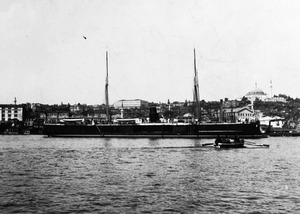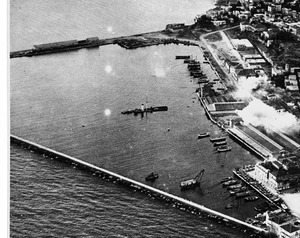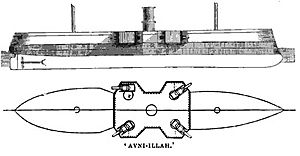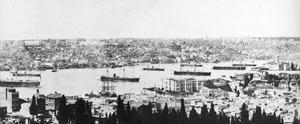Ottoman ironclad Avnillah facts for kids

Avnillah, c. 1885
|
|
Quick facts for kids History |
|
|---|---|
| Name | Avnillah |
| Namesake | "Divine Assistance" |
| Ordered | 1867 |
| Builder | Thames Iron Works |
| Laid down | 1868 |
| Launched | 21 April 1869 |
| Commissioned | 1870 |
| Fate | Sunk, 24 February 1912 |
| General characteristics | |
| Class and type | Avnillah-class ironclad |
| Displacement | 2,362 metric tons (2,325 long tons) |
| Length | 68.9 m (226 ft 1 in) (lpp) |
| Beam | 10.9 m (35 ft 9 in) |
| Draft | 5 m (16 ft 5 in) |
| Installed power |
|
| Propulsion |
|
| Speed | 12 knots (22 km/h; 14 mph) |
| Complement |
|
| Armament | 4 × 228 mm (9 in) guns |
| Armor |
|
The Avnillah (which means "Divine Assistance" in Ottoman Turkish) was a type of warship called an ironclad warship. It was built for the Ottoman Navy in the late 1860s. This ship was the first of its kind in the Avnillah class class. It was constructed in Britain by the Thames Iron Works.
Work on the ship began in 1868. It was launched into the water in 1869. The Avnillah officially joined the fleet in 1870. It was a central battery ship, meaning its main guns were placed in a strong, armored section in the middle. It had four large 228 mm (9 in) guns and could travel at a top speed of 12 knots (22 km/h; 14 mph).
Avnillah took part in the Russo-Turkish War from 1877 to 1878. During this time, it helped Ottoman forces in the Caucasus region. After the war, the ship was kept in reserve and slowly fell into disrepair. By the time the Greco-Turkish War started in 1897, it was in very poor condition. The Avnillah was later updated between 1903 and 1906. After its upgrades, it became a ship used to defend the harbor in Beirut. Sadly, it was sunk by an Italian armored cruiser called Giuseppe Garibaldi during the Battle of Beirut in February 1912. This happened during the Italo-Turkish War.
Contents
What Was the Avnillah Like?
The Avnillah was 68.9 m (226 ft 1 in) long. It had a width of 10.9 m (35 ft 9 in) and a depth of 5 m (16 ft 5 in) underwater. The ship's body was made of iron. It weighed 2,362 metric tons (2,325 long tons) when fully loaded. The crew included 15 officers and 130 sailors.
The ship moved using one compound engine that turned a single screw propeller. Four coal-burning box boilers created the steam needed for the engine. These boilers were connected to a single smokestack in the middle of the ship. The engine could produce 2,200 indicated horsepower (1,600 kW) of power. This allowed the ship to reach a top speed of 12 knots (22 km/h; 14 mph). However, by 1877, its speed had dropped to 10 kn (19 km/h; 12 mph). By 1892, due to poor upkeep, it could only go about 8 kn (15 km/h; 9.2 mph). The Avnillah could carry 220 t (220 long tons; 240 short tons) of coal. It also had sails, like a brigantine rig, to help it move.
The Avnillah was armed with four large 228 mm (9 in) muzzle-loading guns. These guns were placed in a central, armored room called a casemate. Two guns were on each side of the ship. They were set up so that any two guns could fire straight ahead, straight behind, or to either side. The ship's armor belt was 130 to 150 mm (5 to 6 in) thick. The thickest part was above the water, and the thinner part was below. The casemate, where the guns were, had very strong armor, 150 mm thick.
Avnillah's Journey and Battles
The Avnillah was ordered in 1867. Its construction began in 1868 at the Thames Iron Works in Blackwall, London. It was launched on April 21, 1869. The ship was fully ready by 1870 after its sea trials. Once completed, Avnillah and other ironclads were sent to Crete. They helped after the Cretan Revolt of 1866–1869. During this time, the Ottoman fleet did not do much fighting. The Avnillah was part of the II Squadron of the Asiatic Fleet. This squadron also included its sister ship Muin-i Zafer and other ironclads. In its early years, the Ottoman ironclad fleet would go on short trips every summer. This was to make sure their engines were working well.
Fighting in the Russo-Turkish War
The Ottoman fleet started getting ready for war with Russia in September 1876. Tensions had been high for several years. In December 1876, Avnillah and Muin-i Zafer moved to Batumi. This was because Russian naval forces were becoming more active there. The Russo-Turkish War officially began on April 24, 1877. Avnillah spent the war in the Black Sea squadron. The Ottoman fleet in the Black Sea was much stronger than the Russian fleet.
The Ottoman fleet's presence made Russia keep soldiers ready for coastal defense. However, the Ottoman leaders did not use their strong navy to stop the Russian advance. Instead, the fleet went to the eastern Black Sea. There, they helped Ottoman forces fighting the Russians in the Caucasus. The fleet attacked Poti and helped defend Batumi. On May 14, 1877, a group of Ottoman ships, including Avnillah, attacked Russian positions near Sokhumi. They also landed soldiers and gave weapons to local people. This helped start an uprising against the Russians. The Ottomans captured Sokhumi two days later. Russian torpedo boats tried to attack ships in Batumi several times. But Avnillah was not damaged. The fleet continued to support the Ottoman soldiers in Batumi until the war ended.
Later Years and Final Battle

After the war, Avnillah was put away in Constantinople in 1878. It did not see much action for the next twenty years. The yearly summer trips stopped. During this time, the ship received some small upgrades. In 1882, two 87 mm (3.4 in) breech-loading guns were added. It also got new boilers, and its sails were removed. Heavy military masts were put in their place.
By the mid-1880s, the Ottoman ironclad fleet was in bad shape. Avnillah could not even go to sea. Many ship engines were rusted and stuck. Their hulls were covered in marine growth. An expert from Britain thought it would take six months to get just five ironclads ready. During this time, the ship had only about one-third of its usual crew. In 1886, during a time of tension with Greece, the ships were fully crewed. But none of them actually left the harbor. Most ships could only go 4 to 6 knots (7.4 to 11.1 km/h; 4.6 to 6.9 mph) by then.
When the Greco-Turkish War started in February 1897, the Ottomans checked their fleet. They found that almost all ships, including Avnillah, were not ready to fight the modern Greek Navy. Their guns and armor were old. Their crews were not well trained. The Ottoman fleet made a few trips into the Aegean Sea to boost morale. But they did not plan to attack Greek forces. The poor condition of the fleet was clear to everyone. This finally made Sultan Abdul Hamid II agree to a modernization plan. German companies were supposed to rebuild the ships. But they backed out because it was too difficult and the Ottoman government could not pay.
Finally, in 1903, an Italian company, Gio. Ansaldo & C., got the contract to rebuild Avnillah. This work lasted until 1906. Its old guns were replaced with new 150 mm (5.9 in) guns. It also received many smaller, faster-firing guns. These included six 75 mm (3 in) guns, ten 57 mm (2.2 in) guns, and two 47 mm (1.9 in) guns.
By 1910, Avnillah was very old and not useful for battle. It was sent to Beirut to be a stationary defense ship. At this time, it only had four 57 mm (2.2 in) quick-firing guns. In September 1911, Italy declared war on the Ottoman Empire. This started the Italo-Turkish War. Italy was worried that Avnillah might attack their troop ships. So, they decided to get rid of the ship.
On February 24, 1912, two Italian armored cruisers, Giuseppe Garibaldi and Francesco Ferruccio, arrived off Beirut. They demanded that Avnillah be given up. When there was no reply, the Italian ships opened fire. In the Battle of Beirut, the Italians hit Avnillah and set it on fire. Avnillah fired back but did not hit anything. The Italian cruisers then entered the harbor. Giuseppe Garibaldi fired two torpedoes at Avnillah. The first one missed and sank six civilian boats. The second torpedo hit Avnillah in the middle and sank it in the shallow water. About 50 to 60 crew members were killed, and many more were injured.



